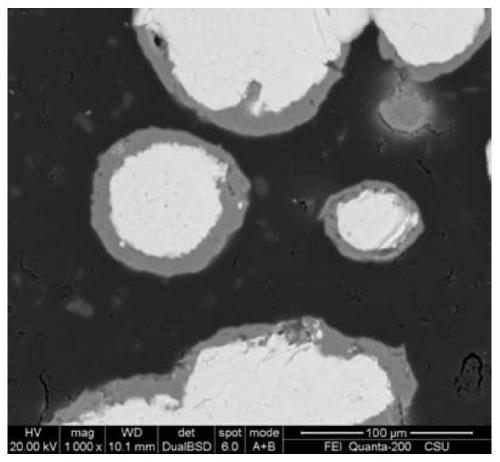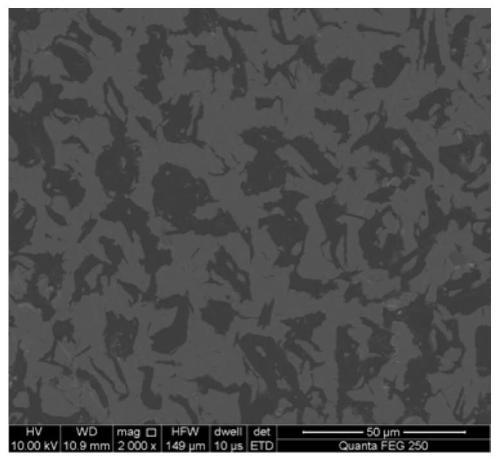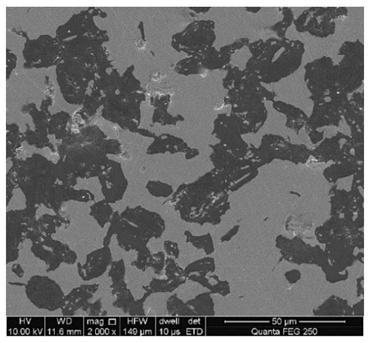A kind of in-situ reaction preparation method of copper-carbon composite material
A composite material and in-situ reaction technology, applied in the field of powder metallurgy, can solve the problems of low density, large wetting angle, low bonding strength, etc., and achieve the effects of improving compressive strength, improving bonding strength, and excellent comprehensive performance.
- Summary
- Abstract
- Description
- Claims
- Application Information
AI Technical Summary
Problems solved by technology
Method used
Image
Examples
Embodiment 1
[0041] Select the copper powder with a particle size range of 50-100 μm and the graphite powder with a particle size range of 30-80 μm as raw materials, prepare copper-carbon composite materials according to the following steps, (1) Copper powder oxidation: 80g copper powder is placed in a tube furnace, Introduce argon for protection, then raise the temperature to 300°C, stop argon, and inhale compressed air at an air flow rate of 1L / min, keep warm for 15 minutes, then stop inflowing air, inhale argon again for protection, and heat up to 850°C, heat preservation for 30 minutes, cooling down to obtain partially oxidized core-shell structure Cu-Cu 2 O powder (see attached figure 1 ), weight gain 2.0g; (2) mixed powder: the Cu-Cu obtained in step (1) 2 O powder is mixed with the graphite powder of 21.5g, adds the alcohol of 1.0% of total mass, carries out powder mixing in V-shape mixer or ball mill, and the time is 30 minutes; (3) vacuum hot pressing: the mixed powder of step (2...
Embodiment 2
[0048] Select copper powder with a particle size range of 50-100 μm and graphite powder with a particle size range of 30-80 μm as raw materials, and prepare copper-carbon composite materials according to the following steps. (1) Copper powder oxidation: put 80g of copper powder in a tube furnace , pass in argon for protection, then raise the temperature to 300°C, stop the argon flow, pass in compressed air, the air flow rate is 1L / min, keep warm for 15 minutes, then stop the flow of air, pass in argon again for protection, and heat up To 850 ℃, heat preservation for 30 minutes, cooling down to obtain partially oxidized core-shell structure Cu-Cu 2 O powder, weight gain 2.0g; (2) mixed powder: the Cu-Cu of step (1) gained 2 O powder is mixed with 62g graphite powder, add the alcohol of total mass 1.0%, carry out powder mixing in V-shape mixer or ball mill, the time is 30 minutes; (3) Vacuum hot pressing: the mixed powder of step (2) gained is cold-pressed After molding, put th...
Embodiment 3
[0055] Select copper powder with a particle size range of 50-100 μm and graphite powder with a particle size range of 30-80 μm as raw materials, and prepare copper-carbon composite materials according to the following steps. (1) Copper powder oxidation: put 120g of copper powder in a tube furnace , pass in argon for protection, then raise the temperature to 300°C, stop the argon flow, pass in compressed air, the air flow rate is 1L / min, keep warm for 15 minutes, then stop the flow of air, pass in argon again for protection, and heat up To 850 ℃, heat preservation for 30 minutes, cooling down to obtain partially oxidized core-shell structure Cu-Cu 2 O powder, weight gain 3.0g; (2) mixed powder: the Cu-Cu of step (1) gained 2 O powder mixes with 47.8g graphite powder, adds the alcohol of gross mass 1.0%, carries out powder mixing in V-shape mixer or ball mill, and the time is 30 minutes; (3) vacuum hot pressing: the mixed powder of step (2) gained is cooled After pressing and f...
PUM
| Property | Measurement | Unit |
|---|---|---|
| particle size | aaaaa | aaaaa |
| particle size | aaaaa | aaaaa |
| particle diameter | aaaaa | aaaaa |
Abstract
Description
Claims
Application Information
 Login to view more
Login to view more - R&D Engineer
- R&D Manager
- IP Professional
- Industry Leading Data Capabilities
- Powerful AI technology
- Patent DNA Extraction
Browse by: Latest US Patents, China's latest patents, Technical Efficacy Thesaurus, Application Domain, Technology Topic.
© 2024 PatSnap. All rights reserved.Legal|Privacy policy|Modern Slavery Act Transparency Statement|Sitemap



